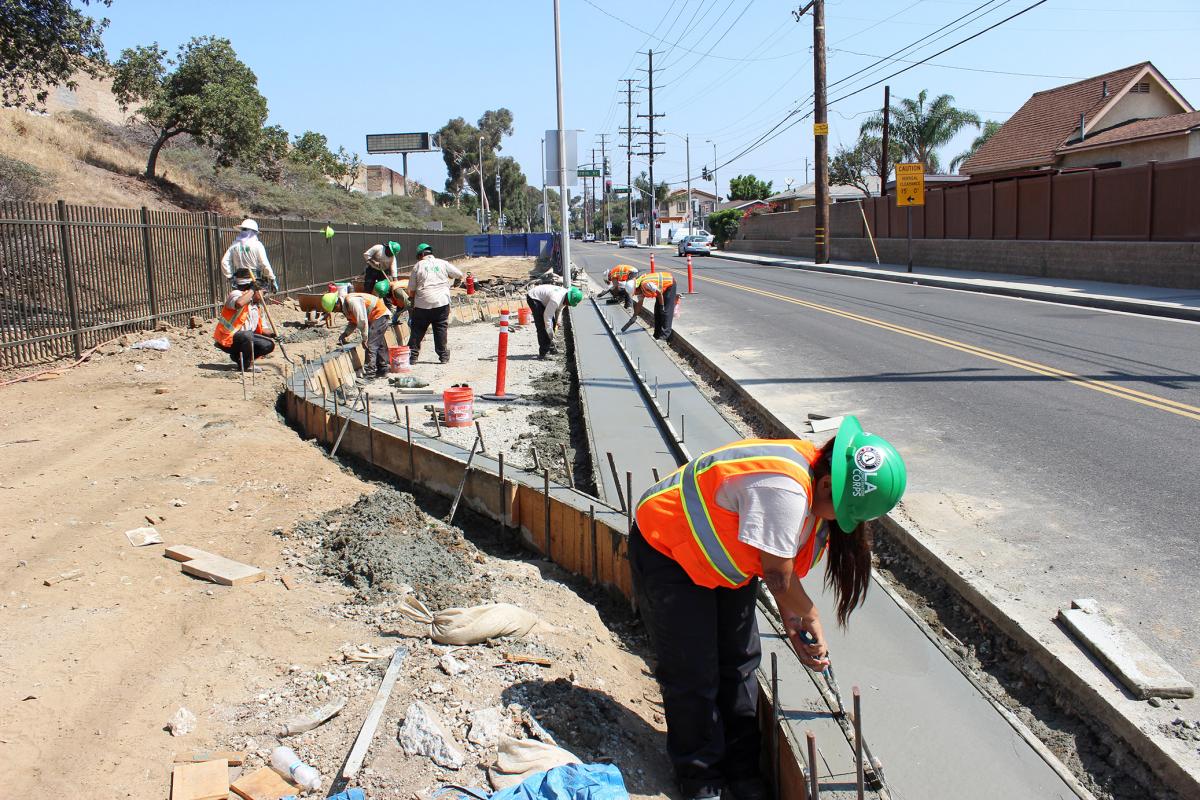

At The Corps Network’s annual National Conference in Washington, DC, we celebrate the important service Corps provide to communities and young people across the country by honoring Corps who have taken on especially noteworthy endeavors within the past year. Projects of the Year are innovative and show a Corps’ ability to work with partner organizations to give Corpsmembers a positive experience and provide the community with meaningful improvements. Learn more.
The Wiseburn Walking Path was designed to confront larger societal concerns around the lack of public outdoor exercise and fitness options within Los Angeles County. The 0.7-mile-long decomposed granite walking path is ADA-Accessible and seeks to improve community health for users of all ages. LA Conservation Corps (LACC) Corpsmembers were the backbone that transformed 3,200 linear feet of essentially unused slope from a regular illegal dumping ground into a valuable community resource.
This project was different than most other LACC endeavors because the Corps was the general contractor, responsible for every aspect of the project. On most LACC construction projects, the Corps is subcontracted to perform specific activities, such as pouring concrete for sidewalks and curbs, planting trees, installing landscaping, and installing park amenities, such as play equipment and signage. This project, however, involved LACC being responsible for all these activities.
Performing the role as a general contractor involved complex permitting and approval processes. Parts of the project crossed into the City of Hawthorne, requiring meetings with Los Angeles County and City of Hawthorne officials. Additionally, the project abutted the right-of-way of the 405-freeway, which required compliance with California Department of Transportation (Caltrans) design standards.
The Corps found ways to work with new partners and leverage existing partnerships to find ways to improve project efficiency. The project was a creative collaboration between LACC, the Los Angeles County Regional Park and Open Space District, County of Los Angeles Department of Parks and Recreation, the California Natural Resources Agency, Supervisor Mark Ridley-Thomas’ Office, the California Department of Transportation, the Wiseburn Watch Community Group, and other constituent groups. Together, this multi-agency and community inclusive partnership worked to ensure that community needs and wants were heard, evaluated, prioritized, and incorporated as much as possible.
The gently meandering path is lined with eight pieces of outdoor exercise equipment. It also features five large seating areas, some with custom-designed hopscotch elements, that provide opportunities for play, rest, and community convening. Additionally, the project included the installation of 45 solar-powered pedestrian light poles and 55 security bollards. More than 150 new trees and 2,000 native plants were installed to provide a tranquil backdrop for users. Each amenity and component was carefully selected to provide physical, mental, and community health benefits.
Constructing the Wiseburn Walking Path Project provided significant job training and employment benefits to LACC Corpsmembers, as well as long-lasting benefits to Wiseburn community members. During the roughly 2.5 years of the project, over 80 Corpsmembers performed more than 13,000 service hours. For the core group of Corpsmembers, the skills learned involved using construction equipment, such as bobcats and skip loaders, performing grading and surveying, pouring and finishing concrete, and installing amenities and other infrastructure. Their on-the-job training offered access to networking opportunities and introduced them to potential career choices. In addition to job training, LACC provided Corpsmembers who lacked a high school diploma the ability to attend classes through a charter school partner.
The project, while complex, is replicable. Similar projects might consider some of these lessons learned: 1) Focus on communication, internally and externally. 2) Set realistic expectations early; over the last two years, LACC regularly attended Wiseburn Watch meetings to not only provide updates, but to ensure that expectations were shared and being met. 3) Don’t assume a project is too big for your Corps. While it is of the utmost importance to work on projects you know you can perform successfully, it is also important to make sure you don’t assume a project is too complex. 4) There is always an opportunity for Corpsmembers to learn. In circumstances when LACC subcontracted other contractors, the Corps often assisted, or at least reviewed the work with Corpsmembers to help expand their knowledge.
Completing the Wiseburn Walking Path has strengthened LACC in many ways. The project increased their capacity to perform large-sale park construction projects; broadened their perspective on which projects they should and shouldn’t take on; and taught them the importance of planning to improve efficiency and effectiveness. The project has helped expand the knowledge, skills, and abilities of Corps staff and Corpsmembers, and has helped refine their approaches to training and mentoring. Finally, the successful completion of the Wiseburn Walking Path Project strengthened LACC’s relationships with a wide array of project partners. LACC is currently working on two projects that are similar to the Wiseburn Walking Path Project and are applying the aforementioned lessons learned.


































































